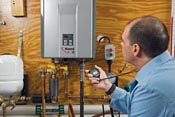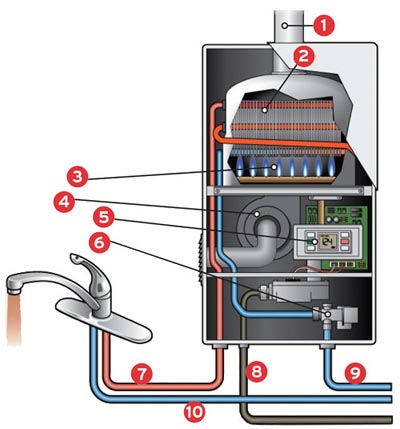They're efficient but not necessarily economical
|
Heating water accounts for up to 30 percent of the average home's energy budget.
Some makers of gas-fired tankless water heaters claim their products can cut your energy costs up to half over regular storage heaters.
So is it time to switch? Probably not. Gas tankless water heaters, which use high-powered burners to quickly heat water as it runs through a heat exchanger, were 22 percent more energy efficient on average than the gas-fired storage-tank models in our tests. That translates into a savings of around $70 to $80 per year, based on 2008 national energy costs. But because they cost much more than storage water heaters, it can take up to 22 years to break even-longer than the 20-year life of many models. Moreover, our online poll of 1,200 readers revealed wide variations in installation costs, energy savings, and satisfaction. |

|
With the help of an outside lab, we pitted Takagi and Noritz gas-fired tankless water heaters against three storage water heaters. We didn't test electric tankless heaters because many can't deliver hot water fast enough to replace a conventional water heater if groundwater is cold. Even in areas with warm groundwater, most homeowners would need to upgrade their electrical service to power a whole-house tankless model.
Our tests simulated daily use of 76 to 78 gallons of hot water. That's the equivalent of taking three showers, washing one laundry load, running the dishwasher once (six cycles), and turning on the faucet nine times, for a total of 19 draws. While that's considered heavy use compared with the standard Department of Energy test, we think it more accurately represents an average family's habits. We also ran more than 45,000 gallons of very hard water through a tanked model and a Rinnai tankless model to simulate about 11 years of regular use.
Here's what else we found:
Water runs hot and cold
Manufacturers of tankless water heaters are fond of touting their products' ability to provide an endless amount of hot water. But inconsistent water temperatures were a common complaint among our poll respondents. When you turn on the faucet, tankless models feed in some cold water to gauge how big a temperature rise is needed. If there's cool water lingering in your pipes, you'll receive a momentary "cold-water sandwich" between the old and new hot water. And a tankless water heater's burner might not ignite when you try to get just a trickle of hot water for, say, shaving.
Nor do tankless water heaters deliver hot water instantaneously. It takes time to heat the water to the target temperature, and just like storage water heaters, any cold water in the pipes needs to be pushed out. And tankless models' electric controls mean you'll also lose hot water during a power outage.
Up-front costs are high
The tankless water heaters we tested cost $800 to $1,150, compared with $300 to $480 for the regular storage-tank types. Tankless models need electrical outlets for their fan and electronics, upgraded gas pipes, and a new ventilation system. That can bring average installation costs to $1,200, compared with $300 for storage-tank models.
Tankless units might need more care
During our long-term testing, an indicator on the tankless model warned of scale buildup. We paid $334 for special valves and a plumber to flush out the water heater with vinegar. Many industry pros recommend that tankless models be serviced once a year by a qualified technician. Calcium buildup can decrease efficiency, restrict water flow, and damage tankless models. Experts suggest installing a water softener if your water hardness is above 11 grains per gallon. Ignoring this advice can shorten your warranty.
Efficient storage models are pricey
We also tested the $1,400 Vertex, a high-efficiency storage water heater by A.O. Smith. The manufacturer claims its installation costs are similar to a regular storage model. But its high cost offsets much of the roughly $70 per year the Vertex will save you. Instead, we recommend buying a conventional storage water heater with a 9- or 12-year warranty. In previous tests, we found that those models generally had thicker insulation, bigger burners or larger heating elements, and better corrosion-fighting metal rods called anodes.
How to choose
Tankless models probably aren't for you if higher up-front costs and long payback are a concern. But they do use less energy and might make sense for long but infrequent use, such as back-to-back showers. Keep these points in mind:
Factor in location
Unlike a regular water heater, a tankless model's water output is immediately affected by groundwater temperatures. The same model that produces 7.2 gallons per minute (GPM) when installed in a warm Florida garage will output only 4.2 GPM in a cold New England basement because the colder water requires the temperature to be raised 77 degrees rather than 44. Use your coldest groundwater temperature to calculate the gallons per minute you'll need.
Know your flow
Undersizing a tankless water heater is a common mistake. Use our online calculator, at www.ConsumerReports.org/hotwater, to help you calculate your hot-water use for both tanked and tankless water heaters.
Get the details right
Look for an oxygen-depletion sensor that shuts off the water heater if carbon monoxide is detected and a film wrap around the heat exchanger that will shut off the device if it gets too hot. Since tankless models are still relatively uncommon, consider using manufacturer-trained installers. Some companies extend the warranty if you do.
Look for rebates or incentives
Many tankless models qualify for utility rebates and state tax credits. Check the Database of State Incentives for Renewables & Efficiency at www.dsireusa.org.
How they work
Tankless models don't store hot water. When hot water is needed, water flows through the device and the flow sensor fires the burner. Water lines around the heat exchanger warm the water to the desired temperature. When the hot-water valve is closed, the flow sensor turns off the burner. (The flow must be fast enough, typically a half-gallon per minute, to turn on the sensor.) Capacity is expressed in gallons per minute.
| 1 - Exhaust |  |
| 2 - Heat exchanger | |
| 3 - Burner | |
| 4 - Fan | |
| 5 - Control panel | |
| 6 - Flow sensor | |
| 7 - Hot water to faucet | |
| 8 - Gas supply | |
| 9 - Cold water coming in | |
| 10 - Cold water to faucet |
What you'll pay
Tankless vs. storage-tank water heaters
We based our comparisons on natural-gas-fueled water heates producing 75 gallons of hot water in a 24-hour period. Water was heated from 54°F to 124° or greater (a 70° temperature rise). Our costs are based on national averages and don't include rebates. Your costs may vary and could shorten or lengthen payback time.
| Tanklss Water Heater |
High-Efficincy Tank
50-Gallon |
Standard Tank 50-Gallon |
||
| Model | Takagi T-K3 | Noritz N-0751M | A.O.Smith Vertex GPHE-50 | GE SG50T12AVH |
| Retail price | $800 |
$1,150 |
$1,400 |
$480 |
| Estimated installation cost |
$1,200 |
$1,200 |
$500 |
$300 |
| Annual operation Cost* | $320 |
$330 |
$331 |
$400 |
| Energy savings (annual over standard tanked unit) |
$80 |
$70 |
$69 |
NA |
| Payback period (years) | 15 |
22 |
16 |
NA |
Consumer Reports Magazine issue: October 2008
